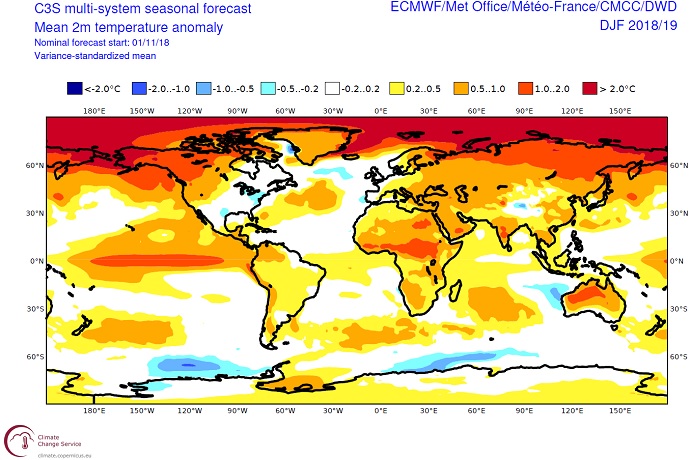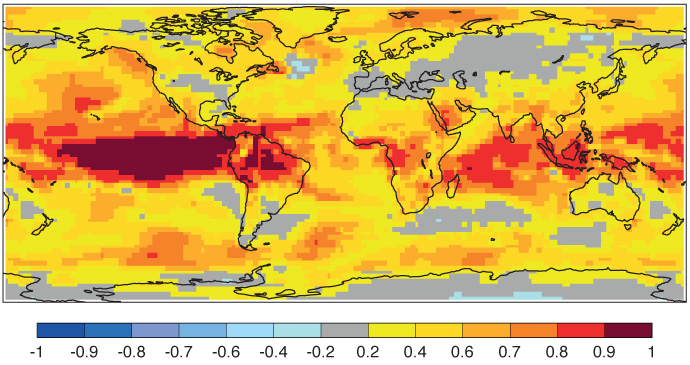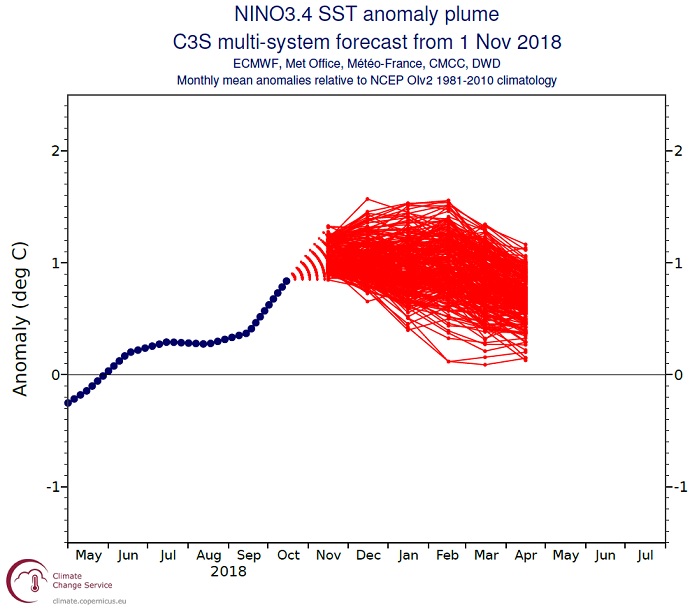

The Copernicus Climate Change Service (C3S), implemented by ECMWF on behalf of the EU, upgraded its seasonal forecast products on 13 November. Forecasts are now available from five models compared to three before, and one of the original models has been upgraded to a new version.
The contributing centres are Météo-France, the UK Met Office, ECMWF and now also the German national meteorological service (DWD) and the Euro-Mediterranean Center on Climate Change (CMCC). Météo-France’s new operational seasonal forecasting system, System 6, has replaced their previous system in the C3S multi-model line-up.
The forecasts include data and graphical products for several variables, including air and sea-surface temperature, atmospheric circulation and precipitation up to six months ahead.

Example C3S multi-model forecast from 1 November 2018 of the ensemble mean 2-metre temperature anomaly for December 2018 – February 2019. Prominent features include higher than normal temperatures predicted for the Arctic region and the tropical Pacific.
The seasonal forecasts will continue to be issued every month on the 13th at 12 UTC. Forecast charts can be accessed on the C3S website and the data is available through the C3S Climate Data Store (CDS), which also provides documentation on the new system.
Skill of seasonal forecasts
Seasonal forecasts cannot predict the weather on particular days and in particular locations. They can, however, highlight the potential for average conditions in a particular region to be above or below what is usual for the time of year.
The average skill of such predictions varies by season and geographic location. A map showing the average skill of ECMWF’s seasonal ensemble mean 2-metre temperature forecasts from 1 November for the December to February period, for example, shows that the skill tends to be low over Europe.

The skill of seasonal forecasts varies by season and by geographic location. In ECMWF’s SEAS5 system, it tends to be relatively low over Europe. The chart shows the anomaly correlation for ensemble mean 2-metre temperature predictions for December–January–February from 1 November for SEAS5. The anomaly correlation is a measure of skill. A value of 1 corresponds to a perfect deterministic forecast, while 0 means no skill.
Experience shows that on average multi-model seasonal forecasts perform better than any single system. They also provide additional information on the degree of uncertainty that comes with any forecast.
Predictability on seasonal timescales depends on ‘teleconnections’ in the Earth system. For example, El Niño conditions, marked by unusually high sea-surface temperatures in the equatorial Pacific Ocean, can have repercussions on weather patterns across the world.
El Niño conditions have relatively high predictability, but predictions still come with some uncertainty, as illustrated by the C3S seasonal multi-model forecast for the NINO3.4 region below.

This example shows a C3S multi-system forecast of sea-surface temperature (SST) anomalies in the NINO3.4 region in the tropical Pacific from 1 November 2018. Each line represents a member of an ensemble forecast issued by the participating centres. The spread of the lines gives an indication of the uncertainty in the forecast.
Next steps
Further significant changes to the C3S multi-model seasonal forecast service are expected in 2019.
Forecast verification statistics will be shown alongside the forecast products. In addition, new contributors, such as the US National Centers for Environmental Prediction (NCEP) and the Japan Meteorological Agency (JMA), are expected to be included in the multi-system.
At that point the C3S system will include data from all models currently participating in EUROSIP, a multi-system seasonal forecast activity coordinated by ECMWF since 2005.
Top image: kwasny221/iStock/Thinkstock
